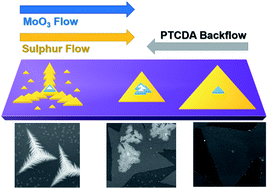Influence of organic promoter gradient on the MoS2 growth dynamics†
Abstract
Chemical vapor deposition has been demonstrated to be the most efficient, versatile and reliable technique for the synthesis of monolayers of transition metal dichalcogenides. The use of organic promoters during the growth process was a turning point in order to increase the monolayer lateral size or to obtain complete coverage of the growth substrate. In this work we clarify the influence of the promoter gradient on the growth dynamics of MoS2. In particular, we place a sacrificial substrate covered with a promoter (a low sublimation-temperature perylene-based compound) downstream with respect to the growth substrate in order to maximize its gradient on the growth substrate through upstream diffusion. We demonstrate that the morphology and the number of layers of MoS2 are drastically affected by the distance of the growth substrate from the promoter sacrificial substrate. The farthermost area from the promoter substrate presents micrometric MoS2 triangular monolayers and large low hierarchy dendritic multi-layer structures. On the contrary the closest area reveals an almost continuous polycrystalline MoS2 monolayer, with bilayer terraces, with a lateral dimension up to hundreds of micrometers.



 Please wait while we load your content...
Please wait while we load your content...